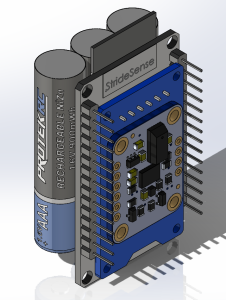Reva Poddar’s Status Report for 12/7
Progress Update:
This week, I fine-tuned the data processing algorithms, focusing on enhancing noise reduction and optimizing pitch-based thresholding for footstrike detection. The refined algorithms were integrated into the main application and tested using simulated datasets. These tests demonstrated that metrics like footstep detection are functioning well overall, but using this data to calculate stride length has proven more challenging due to variations in user gait and step patterns. The app’s existing visualization was instrumental in verifying real-time data flow and detection accuracy.
Challenges Faced:
- Stride Length Calculation: Developing a reliable method to compute stride length from footstep detection data, accounting for individual variations in stride dynamics.
- Real-Time Integration: Ensuring the processing algorithms operate efficiently within the app without impacting performance.
- Edge Cases: Simulated datasets highlighted specific scenarios, such as abrupt movement changes, that require further refinement in the detection algorithms.
Next Steps:
- Test the app with live data collected from real-world runs to validate the algorithms under dynamic conditions and gather insights for stride length calculation.
- Refine the detection algorithms to improve robustness in handling edge cases and variability in user gaits.
- Seek feedback from initial users to identify pain points and guide further optimization of both detection and stride length computation.
Vansh Mantri’s Status Report for 12/7
Testing Summary Findings:
Usability & Comfort
- Participants reported the device as easy to use, quickly adapting to its setup.
- Feedback on comfort was positive overall. However, the shortest participant suggested slight material adjustments to enhance the fit.
Step-Count Refinement
- Improved calibration of the step-detection algorithm ensured accurate results for all participants, regardless of differences in stride length or height.
Casing and Battery
- Developed a functional casing for the insole and integrated LIPO battery for reliable, rechargeable power.
- Ensured optimal battery placement for comfort and functionality, balancing weight distribution effectively.
- Also made a CAD model


Final Presentation
- Refined the project’s final presentation to effectively communicate goals, challenges, and progress to stakeholders.
- Integrated detailed visuals and data to showcase testing results and technical milestones clearly.
- Started Final Report
Team Status Report for 12/6
Team Status Report
Testing Summary Findings (Vansh)
- Usability & Comfort:
- Participants reported the device as easy to use and quickly adapted to its setup.
- Comfort feedback was positive overall, but the shortest participant suggested slight material adjustments to enhance the fit.
- Step-Count Refinement:
- Improved calibration of the step-detection algorithm ensured accurate results across participants, accommodating differences in stride length and height.
- Casing and Battery:
- Developed a functional casing for the insole and integrated a LIPO battery for reliable, rechargeable power.
- Ensured optimal battery placement for comfort and balanced weight distribution effectively.
- Created a detailed CAD model for the casing design.
- Final Presentation:
- Refined the project’s final presentation to communicate goals, challenges, and progress effectively to stakeholders.
- Integrated detailed visuals and data to showcase testing results and technical milestones clearly.
- Started drafting the final report.
Progress Update (Reva)
- Algorithm Development:
- Fine-tuned data processing algorithms with a focus on noise reduction and optimizing pitch-based thresholding for footstrike detection.
- Integrated the refined algorithms into the main application and tested them using simulated datasets.
- Testing Outcomes:
- Metrics like footstep detection performed well during tests, but stride length calculation remains challenging due to variations in user gait and step patterns.
- Leveraged the app’s visualization tools to verify real-time data flow and detection accuracy.
- Challenges:
- Stride Length Calculation: Accounting for individual variations in stride dynamics to compute stride length reliably.
- Real-Time Integration: Ensuring efficient algorithm performance within the app.
- Edge Cases: Addressing abrupt movement changes highlighted during simulated dataset tests.
Next Steps (Combined):
- Real-World Testing:
- Conduct live data tests with real-world runs to validate algorithms under dynamic conditions and improve stride length calculations.
- Algorithm Refinement:
- Enhance detection algorithms for robustness in handling edge cases and variability in user gaits.
- Continue optimizing stride length computation methods.
- User Feedback:
- Seek feedback from initial users to identify pain points and guide further improvements in both detection algorithms and stride length calculations.
- Finalization Efforts:
- Complete bilateral testing with the second insole prototype.
- Finalize the project’s presentation and report, incorporating additional data visualizations and insights from real-world testing.
This comprehensive report outlines progress, key findings, challenges, and next steps, ensuring alignment across the team.
